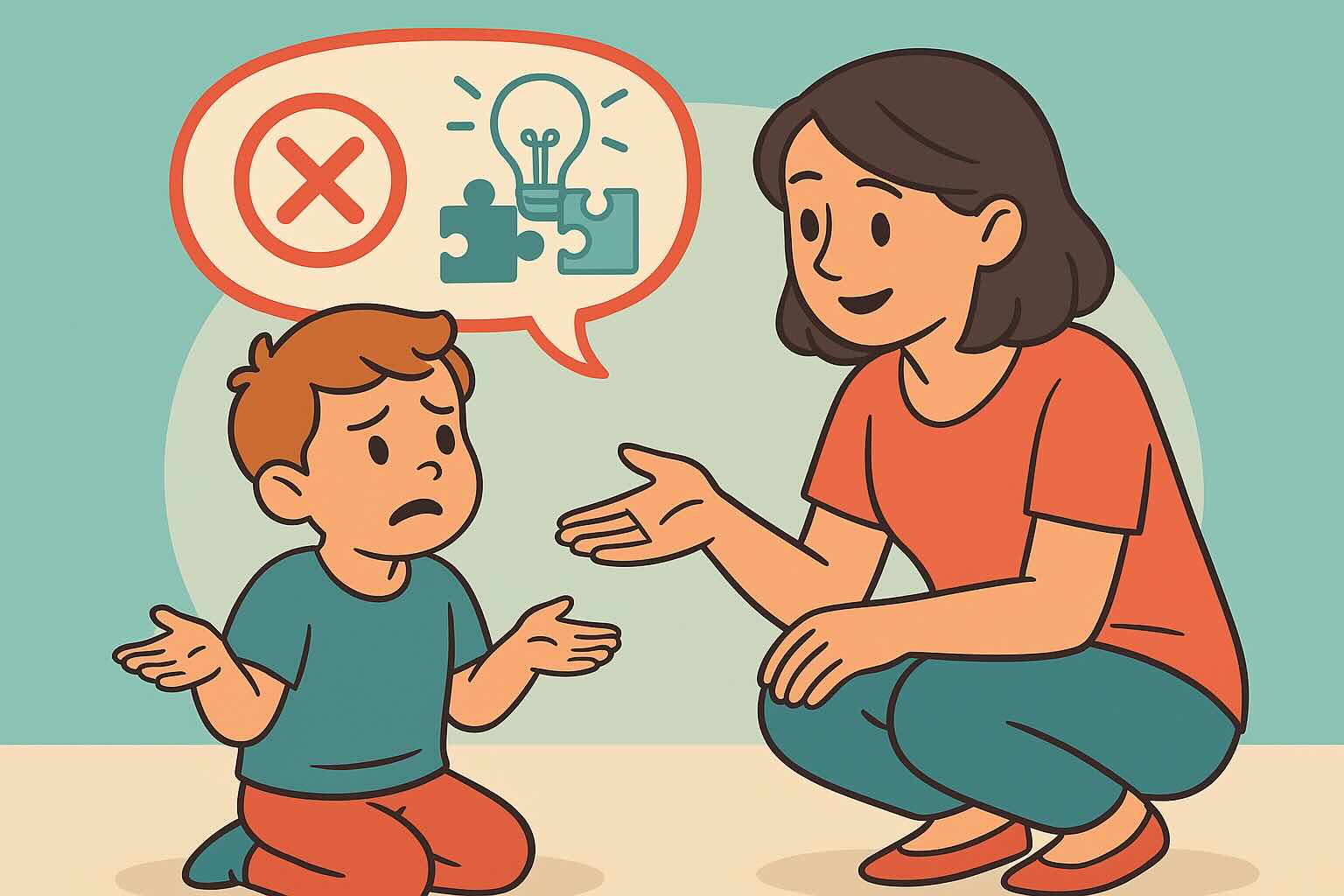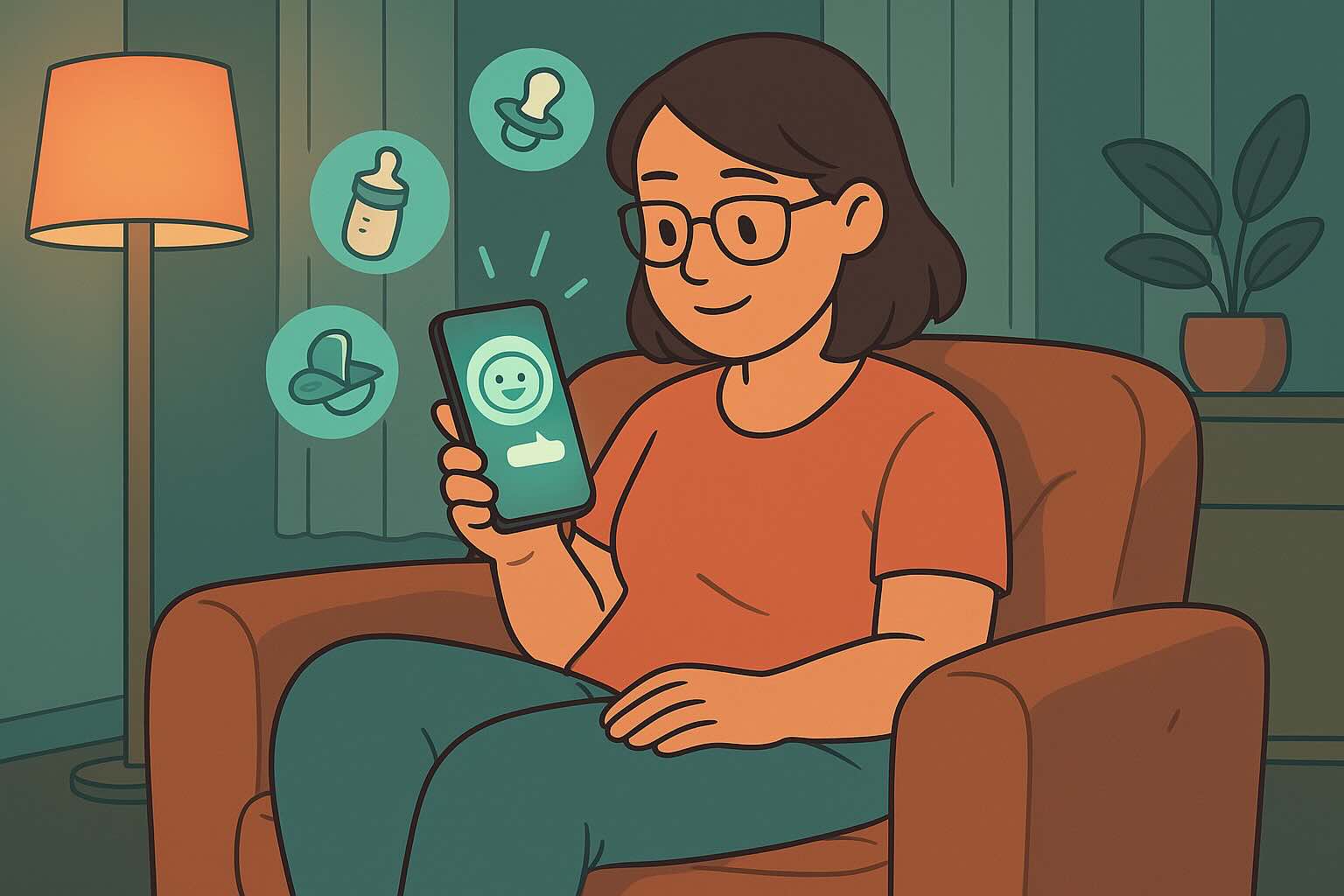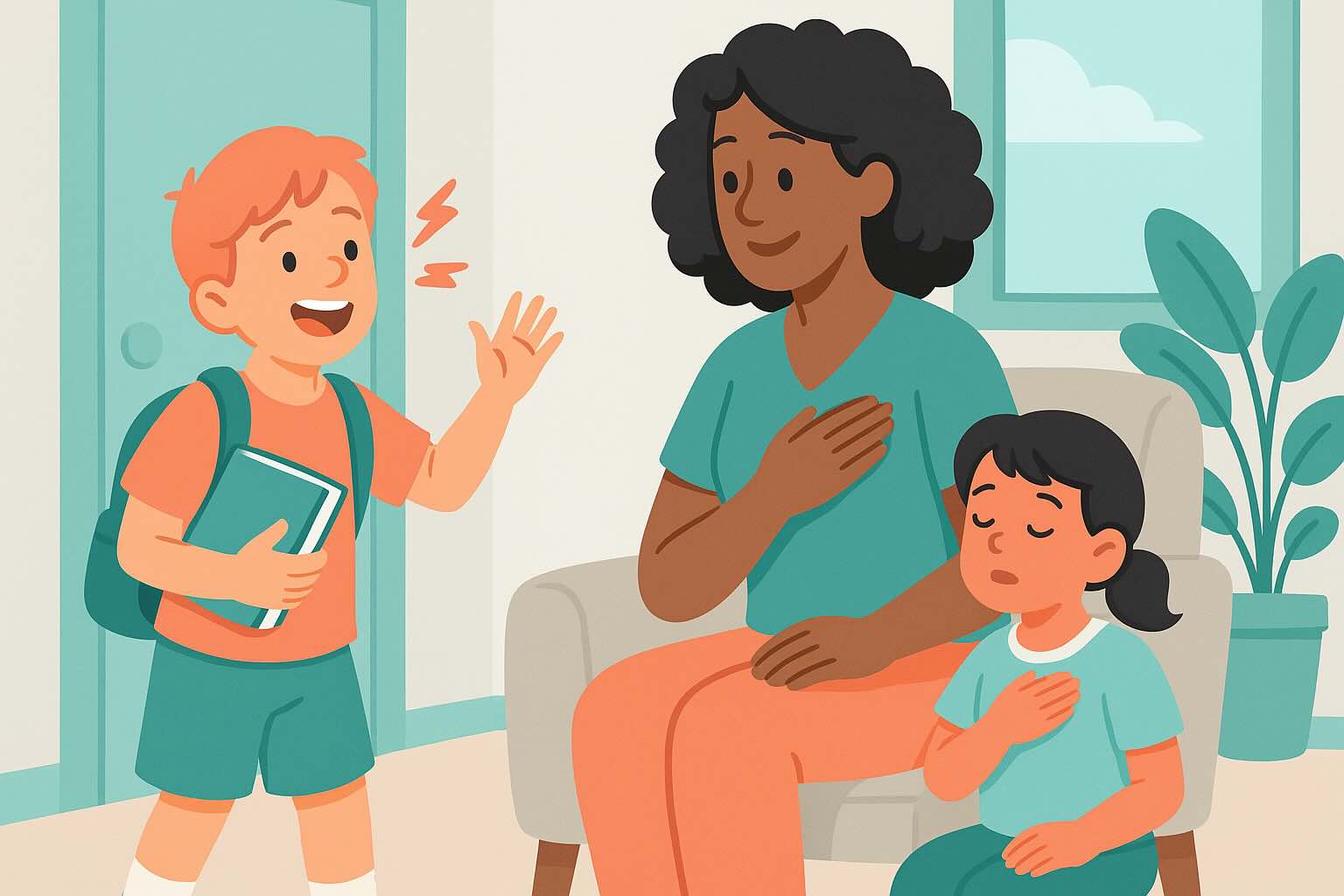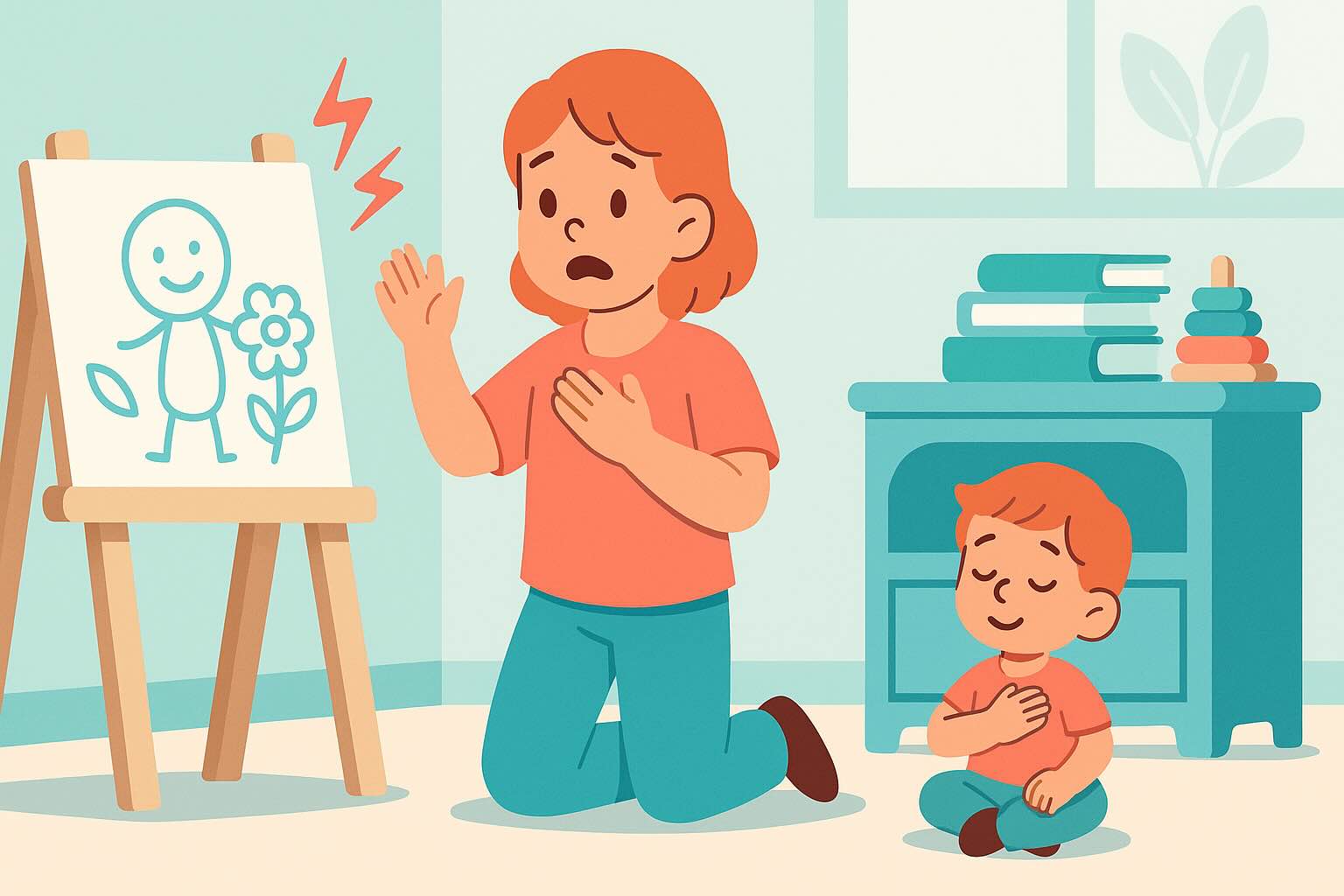Curious Not Furious: 5 Questions That Transform Battles


Your 5-year-old refuses to put on their shoes for school. Again. Your first instinct might be: "Why do you always do this? We're going to be late! Just put your shoes on!" But what if this frustrated approach is actually creating the very resistance you're trying to overcome?
Curious not furious is the mindset that approaches challenging behaviors with genuine wonder and collaborative problem-solving instead of anger and control. When you get curious about what's really happening for your child, you transform daily battles into opportunities for connection, learning, and skill-building.
This comprehensive guide will show you how to replace power struggles with partnership, helping your child develop critical thinking skills while making your family life significantly more peaceful. For related approaches, see our connection before correction guide and natural consequences strategies.
What You'll Learn in This Guide
- The Power of Genuine Curiosity - How questions change brain states and relationships
- Why Power Struggles Happen - Understanding the psychology behind resistance
- Curious Questions That Work - Specific language that opens dialogue instead of defense
- Age-Appropriate Problem-Solving - What collaboration looks like for 3-4 vs 5-7 year olds
- From Furious to Curious in Real Time - Practical strategies for shifting your mindset
- Building Problem-Solving Skills - Teaching children to think through challenges
- Collaborative Solutions - Working together instead of imposing your will
- Creating a Problem-Solving Family Culture - Making teamwork your default approach
Estimated reading time: 12 minutes
The Science Behind Curiosity vs. Fury
How Curiosity Changes Brain States
When you approach with curiosity:
- Your prefrontal cortex (thinking brain) stays active
- Stress hormones remain low
- Mirror neurons help your child feel understood
- Creative problem-solving centers activate
- Relationship and connection areas engage
When you approach with fury:
- Your amygdala (fear/anger center) takes over
- Stress hormones flood your system
- Your child's defense mechanisms activate
- Problem-solving abilities shut down
- Relationship damage occurs
The Contagion Effect
Your emotional state directly influences your child's:
- Curious parent → curious, thinking child
- Furious parent → defensive, reactive child
- Collaborative energy → cooperative responses
- Adversarial energy → oppositional responses
Research shows: Children mirror their parent's emotional regulation and problem-solving approaches throughout their lives.
Understanding Why Power Struggles Happen
The Psychology of Resistance
Children resist when they feel:
- Controlled rather than collaborated with
- Misunderstood or unheard
- Like their autonomy is threatened
- Defensive about their capabilities
- Disconnected from their parent
Power struggles intensify when:
- Parent and child are on opposite teams
- The focus is on winning rather than understanding
- Emotions escalate on both sides
- Creative solutions aren't explored
- Underlying needs aren't addressed
The Curious Alternative
When you get curious, you:
- Join your child's team instead of opposing them
- Seek to understand rather than control
- Address underlying needs and feelings
- Engage their problem-solving brain
- Build skills for future challenges
Example transformation:
- Furious approach: "Why won't you clean your room? You're so messy!"
- Curious approach: "I notice cleaning up feels really hard for you. What makes it challenging?"
The Art of Asking Curious Questions
Genuine vs. Leading Questions
Genuine curious questions:
- Come from real interest in understanding
- Have no predetermined "right" answer
- Open up dialogue and exploration
- Help you learn about your child's inner world
- Build trust and connection
Leading questions (avoid these):
- "Don't you think you should share?"
- "Why can't you be nice like your sister?"
- "How do you think that makes me feel?"
- "What did you do wrong?"
Effective Curious Question Starters
For understanding feelings:
- "I'm curious what that felt like for you..."
- "I wonder what was going through your mind when..."
- "Help me understand what's happening for you..."
- "What was the hardest part about..."
For problem-solving:
- "What ideas do you have for..."
- "I wonder what would happen if..."
- "What do you think we could try..."
- "How might we solve this together..."
For gathering information:
- "Tell me more about..."
- "What did you notice when..."
- "I'm curious about your thinking on..."
- "What would help you with..."
Age-Specific Curious Approaches
Ages 3-4: Simple Wonder and Concrete Solutions
Young children need simple, concrete curiosity that matches their developmental stage.
Effective curious language:
- "I wonder why putting on shoes feels hard today"
- "What would make cleaning up more fun?"
- "Help me understand what happened"
- "What do you think your teddy bear would do?"
Problem-solving at this age:
- Offer 2-3 concrete options
- Use visual aids or demonstrations
- Make it playful when possible
- Keep solutions simple and immediate
Example scenario: Bedtime resistance
- Furious: "Stop fighting bedtime! You need to go to sleep!"
- Curious: "I'm noticing bedtime feels hard tonight. What would help you feel ready for sleep? Should we pick out tomorrow's clothes first or read an extra story?"
Ages 5-7: Expanded Thinking and Complex Solutions
Older children can engage in more sophisticated problem-solving and understand multiple perspectives.
Effective curious language:
- "I'm curious about your perspective on this situation"
- "What solutions can we brainstorm together?"
- "Help me understand your thinking process"
- "What would you do if you were in my position?"
Problem-solving at this age:
- Encourage multiple solution generation
- Discuss pros and cons of different approaches
- Consider other people's perspectives
- Plan for future similar situations
Example scenario: Homework resistance
- Furious: "Why can't you just do your homework without arguing?"
- Curious: "I notice homework has been feeling overwhelming lately. What's making it hard? Let's brainstorm some ways to make it feel more manageable."
Shifting from Furious to Curious in Real Time
The PAUSE-WONDER-ASK Method
PAUSE: Take a breath and notice your emotional state
- "I'm feeling frustrated right now"
- "My first instinct is to get angry"
- "Let me step back for a moment"
WONDER: Shift to genuine curiosity about your child's experience
- "I wonder what's really going on for them"
- "What might they be struggling with?"
- "What need are they trying to meet?"
ASK: Pose a genuine question from curiosity
- "Help me understand what's happening for you"
- "What's making this hard right now?"
- "What ideas do you have for solving this?"
Reframing Challenging Behaviors
Instead of: "They're being defiant" Wonder: "What need are they trying to meet?"
Instead of: "They never listen" Wonder: "What's making it hard for them to hear me?"
Instead of: "They're being difficult" Wonder: "What challenge are they facing?"
Physical Cues for Curiosity
Body language that supports curiosity:
- Get on your child's physical level
- Open posture (uncrossed arms)
- Relaxed facial expression
- Slower, calmer movements
- Gentle eye contact
Building Problem-Solving Skills Through Curiosity
The Collaborative Problem-Solving Process
Step 1: Define the problem together
- "So it sounds like the challenge is..."
- "Help me make sure I understand..."
- "What do you see as the main problem?"
Step 2: Generate solutions together
- "What ideas do you have?"
- "What are some things we could try?"
- "What would happen if we..."
Step 3: Evaluate options together
- "What do you think about that idea?"
- "What might be challenging about that solution?"
- "Which option feels best to you?"
Step 4: Try and adjust together
- "Let's try this and see how it works"
- "If this doesn't work, what could we try next?"
- "What did we learn from trying that?"
Teaching Thinking Skills
Help your child develop:
- Perspective-taking: "How do you think your sister felt when...?"
- Cause-and-effect thinking: "What do you think might happen if...?"
- Creative problem-solving: "What are some unusual ways we could...?"
- Planning skills: "What would we need to do first?"
Real-Life Curious Problem-Solving Examples
Morning Routine Challenges
The situation: Child consistently dawdles getting ready
Furious approach: "Why are you so slow? We're always late because of you! Just get dressed!"
Curious approach: "I've noticed mornings feel really hard for you. I'm curious what makes getting ready challenging. What ideas do you have for making mornings smoother?"
Collaborative solutions might include:
- Setting up clothes the night before
- Creating a morning checklist with pictures
- Playing energizing music during routine
- Breaking tasks into smaller steps
Sibling Conflicts
The situation: Children fighting over toys
Furious approach: "Stop fighting! Why can't you two ever get along? Someone's going to lose the toy!"
Curious approach: "I see two people who both really want the same toy. This is a tricky problem. What ideas do you both have for solving this?"
Collaborative solutions might include:
- Taking turns with a timer
- Playing together with the toy
- Finding a similar toy for the other child
- Creating a sharing schedule
Chore Resistance
The situation: Child avoids helping with household tasks
Furious approach: "You never help! Everyone else has to do everything while you play!"
Curious approach: "I notice helping around the house doesn't feel fun for you. I'm curious what would make contributing to our family feel better. What are your thoughts?"
Collaborative solutions might include:
- Choosing preferred chores from a list
- Working together as a team
- Setting up reward systems they help design
- Making chores more playful or music-filled
Creating a Problem-Solving Family Culture
Family Problem-Solving Meetings
Weekly family meetings can include:
- Celebrating successful problem-solving from the week
- Discussing ongoing challenges that need collaborative solutions
- Brainstorming improvements to family systems
- Planning fun activities together
Structure for family meetings:
- Appreciation: What went well this week?
- Challenges: What problems do we need to solve?
- Solutions: What ideas does everyone have?
- Planning: What will we try this week?
Teaching Problem-Solving Language
Help your child develop problem-solving vocabulary:
- "That's an interesting challenge"
- "What are our options?"
- "Let's brainstorm some ideas"
- "What would happen if...?"
- "That didn't work, what else could we try?"
Celebrating Creative Solutions
When your child comes up with solutions:
- Acknowledge their thinking: "That's creative problem-solving!"
- Ask about their process: "How did you think of that?"
- Appreciate their effort: "I love how you kept trying different ideas"
- Build their confidence: "You're becoming a great problem-solver!"
Your 4-Week Curious Parenting Development Plan
Week 1: Mindset and Awareness
- Notice when you default to furious instead of curious
- Practice the PAUSE-WONDER-ASK method during minor challenges
- Start using genuine curious questions in daily interactions
- Work on shifting your internal narrative about challenging behaviors
Week 2: Curious Question Building
- Develop your repertoire of curious questions for different situations
- Practice asking questions without hidden agendas
- Focus on truly wanting to understand your child's perspective
- Work on your tone and body language to match your curiosity
Week 3: Collaborative Problem-Solving
- Begin involving your child in solution generation
- Practice the collaborative problem-solving process
- Allow your child's ideas to influence outcomes when appropriate
- Focus on building their thinking skills through the process
Week 4: Family Culture Integration
- Implement family problem-solving meetings or discussions
- Create systems for ongoing collaborative problem-solving
- Celebrate instances of creative thinking and problem-solving
- Evaluate progress and plan for maintaining curious approaches
Signs Your Curious Approach is Working
Immediate Signs (1-2 weeks)
- Your child becomes less defensive during conflicts
- They start offering their own ideas and solutions
- Power struggles decrease in intensity and frequency
- You feel more connected to your child during challenges
Medium-term Signs (3-4 weeks)
- Your child begins approaching you with problems
- They show increased creativity in problem-solving
- Family conflicts resolve more quickly and peacefully
- Your child demonstrates improved critical thinking skills
Long-term Signs (2-3 months)
- Your child develops independent problem-solving abilities
- They show empathy and consideration for others' perspectives
- Family culture feels more collaborative and team-oriented
- Your child becomes more resilient when facing challenges
Common Curious Parenting Challenges
"My child says 'I don't know' to everything"
This often means:
- They don't feel safe sharing their real thoughts
- They're overwhelmed and can't access their thinking
- They need more time to process
- Your questions might feel like tests
Try instead:
- Offering observations: "I noticed you seemed frustrated when..."
- Giving multiple choice options: "Were you feeling angry, sad, or something else?"
- Waiting longer for responses
- Sharing your own wondering: "I wonder if you felt..."
"Being curious takes too much time"
Remember:
- Curiosity prevents repeated conflicts
- A 5-minute curious conversation can prevent a 30-minute power struggle
- Children who feel heard cooperate more quickly over time
- Problem-solving skills reduce future challenges
"My child tries to manipulate the process"
This is actually progress - they're:
- Learning to think strategically
- Testing boundaries within the new system
- Developing negotiation skills
Maintain boundaries while staying curious:
- "I appreciate your creative thinking AND we still need to..."
- "That's an interesting idea. Let's think about whether it would work for everyone"
Key Takeaways: Your Curious Not Furious Guide
- ✅ Curiosity transforms adversaries into teammates - you and your child work together instead of against each other
- ✅ Genuine questions open dialogue - while accusations create defensiveness
- ✅ Children are naturally problem-solvers - when given the chance and support
- ✅ Your emotional state influences theirs - curious parent creates curious child
- ✅ Problem-solving skills transfer - children use these abilities in all areas of life
- ✅ Power struggles waste energy - collaboration builds skills and connection
- ✅ Age-appropriate expectations matter - match your approach to developmental stage
- ✅ Practice makes progress - shifting from furious to curious takes time
- ✅ Family culture can change - consistent curious approaches transform dynamics
- ✅ Solutions work better when children help create them - ownership increases cooperation
Remember: Every time you choose curiosity over fury, you're teaching your child that problems are solvable, their perspective matters, and thinking is valued over compliance. You're building a problem-solver, a critical thinker, and a collaborative family member. The challenges you face today become the foundation for the capable, thoughtful adult your child will become.
This article is based on collaborative problem-solving research, child development psychology, and conflict resolution theory. Every family's journey toward more curious, collaborative relationships is unique, and developing these skills takes patience and practice. Focus on progress rather than perfection as you build your curious parenting abilities.
24/7 AI Parenting Assistant
Get instant, personalized advice with expert-curated parenting knowledge. Chat with your AI coach anytime, anywhere.

Connection Before Correction Toolkit
Daily practices and scripts to build strong parent-child relationships that make behavior guidance more effective.
Frequently Asked Questions
Need personalized support?
RootWise's AI coach can provide tailored strategies for your specific situation, available 24/7 when you need it most.
Learn More About AI Coaching →



